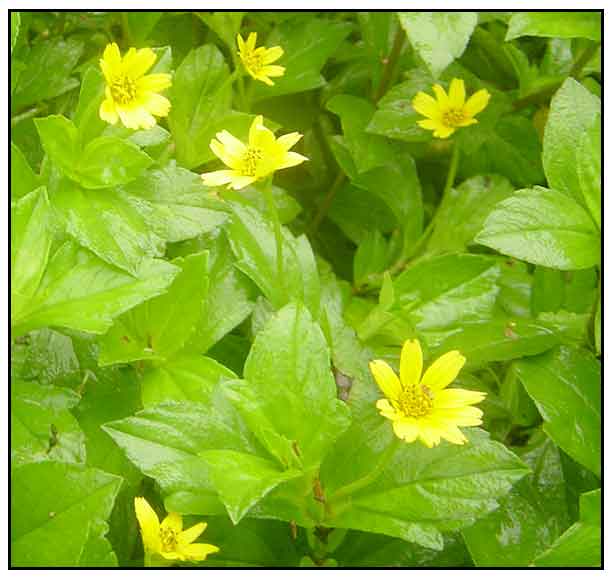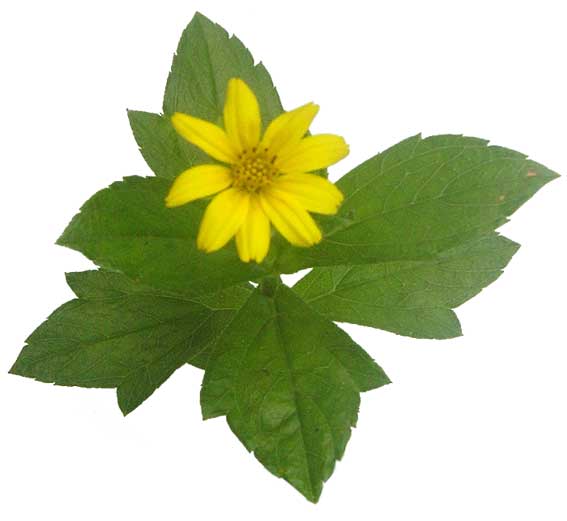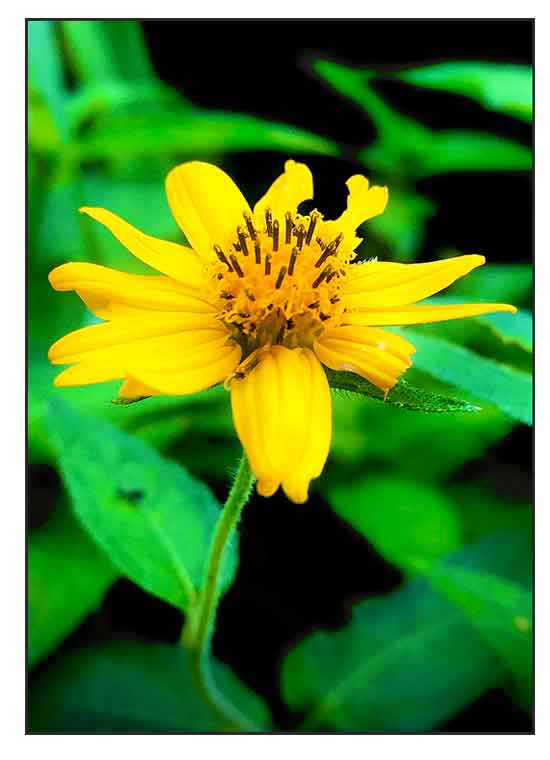 Gen info Gen info
- Although known officially as Sphagneticola trilobata, its is commonly referred to by its former name, Wedelia trilobata.
-
Genus Wedelia, named in honor of Georg Wolfgang Wedel (1645-1721).
- It
has about 70 species of tropical and subtropical regions. (9)
-
Etymology: The genus name Sphagneticola means sphagnum dweller, a possible reference to the plant's ability to survive in waterlogged or flooded areas. The specific epithet trilobata refers to its three-lobed leaves. (36)
Botany
A creeping, succulent mat-forming
perennial herb, with rounded stems rooting at the nodes. Stems are rounded, green or reddish, occasionally coarsely hairy. Leaves are
opposite, ovate, dentate, shallowly or deeply 3-cleft, glossy and green, irregularly toothed, sessile or borne on short stalks. Flowers
are daisy-like, golden yellow, 2 centimeters across, borne singly at the end of the stem. Each flower head has 8 to 13 yellowish petals, with 1 to 3 finely toothed tips. At the center of the flower heads, there are numerous tiny yellow tubular disc florets, 4 to 5 millimeters long. Fruit is a 2- to 4-angled achene.
 Distribution Distribution
- Introduced.
- Makes an excellent and decorative ground cover.
- Native to Mexico, Central America, and throughout the Caribbean. Escaped in many tropical regions including Australia, Pacific Islands, Malaysia, Indonesia, Thailand, India, Papua New Guinea. (9)
Invasiveness
- It is listed in the IUCN's list of "World's 100 worst invasive species". It spreads vegetatively, not by seed, forming a dense ground cover, crowding and preventing other plant species from regenerating. It is an invasive species on the Pacific Islands, Hong Kong, South Africa, Australia, Indonesia, and Sri Lanka. (26)
Constituents
• Study isolated main bioactive
sesquiterpene lactones, trilobolid-6-O-isobutyrates A and B.
• From the flower, the structure of trilobolide-6-O-isobytyrate
shows a eudesmanolide sesquiterpene skeleton. (5)
• Contains the diterpene (kaurenoic acid), eudesmanolide lactones and luteolin (in leaves and stems.
• Major classes of phytoconstituents in the plant include tannin, saponins, flavonoids, phenol, terpenoids.
It contains high amount of diterpene, eudesmanolide lactones, and luteolin. (9)
• GC-MS analysis of leaves for essential oil yielded α-pinene (>30%), α-phellandrene (17.4%) and limonene (16.3%) as major components. (9)
• Study of leaves, stems, and flowers for essential oil yielded a high percentage of hydrocarbon sesquiterpenes (25.5-86.4%), hydrocarbon monoterpenes (22.9-72.3%) and low levels of oxygenated sesquiterpenes (0.0-7.4%). Major components of volatile oils were germacrene D (11.9-35.8%),
α-phellandrene (1.4-28.5%), α-pinene (7.3-23.8%), E-caryophyllene (4.6-19.0%), bicyclogermacrene (6.0-17.0%), limonene (1.8-15.1%), and α-humulene (4.0-11.6%). (9)
- Qualitative phytochemical screening of powdered leaves, stems, and roots using four solvents viz. ethanol, petroleum ether, chloroform and water yielded alkaloids, flavonoids, saponins, terpenoids, steroids, glycosides, tannins, proteins, amino acids and carbohydrates. More phytochemicals were found in extracts prepared by ethanol.
(12)
- Phytochemical analysis of methanol and chloroform extracts of flower yielded
cardiac glycosides (M++ C+), steroids (M+C+), flavonoids (M+), saponin (M+), tannins (M+), terpenoids (M+C+), alkaloids (M+). (14)
- Hydrodistillation of leaves for essential oil had percentage yield of 0.21 ± 0.01% (v/w) with a total of 112 chemical compounds representing 62$ of the total oil by GC-MS. Main bioactive constituents were monoterpenes, α-pinene (19.5%), α-phellandrene (7.4%), limonene (3.6%), oxazine (3.3%), and ß-pinene (3.1%). (see study below) (16)
- Phytochemical screening of methanol leaf extract yielded alkaloids +++, flavonoids +++, saponins +++, triterpenoids ++, steroids ++, glycosides +, tannins ++, quinones ++,. reducing sugar +, phenol ++.
(33)
- GC-MS study of methanol leaf extract yielded: 1-dodecene, 1-tetradecanol, 2,4-ditert-butylphenyl, tetradecanol, 1-heptadecene, neophytadiene, 6-octen-1-oil, 1,2-benzenedicarboxyl, 1-heptadecene, phenanthrene, squalene, octadecamethyl-, beta-amyrin, cyclononasiloxane. (see study below) (33)
Properties
• Studies have suggest analgesic, antimicrobial, anti-inflammatory, antihyperglycemic, wound healing, antidiabetic, antileukemic, anti-aging, anticancer, tyrosinase inhibitory properties.
Parts
utilized
Leaves, fruits, stems, flowers.
 Uses Uses
Folkloric
• No reported folkloric medicinal use in the Philippines.
• In Trinidad and Tobago, used for reproductive
problems, amenorrhea, dysmenorrhea.
• In South
America, used to treat symptoms of colds and flu; for fevers and inflammations.
• In Caribbean and Central Americatraditional medicine, used for bronchitis, colds, abdominal pains, dysmenorrhea and as fertility enhancer. (9)
• In Nicaragua, Miskito Indians use leaves for treatment of kidney problems, colds, stingray wounds, snakebite, amenorrhea. (9)
- Fruits, leaves, and stems used in childbirth and for treatment of bites, stings, fever and infection. In Vietnam used for treatment of fever and malaria. (9)
• In the Dominican Republic, used for the treatment of menorrhagia.
• In Guyana, strong decoction used for treatment of severe chest colds. Tea or syrup mixed with Lantana camara used for colds. Mixture of boiled leaves with Commeline nudiflora or Hibiscus sabdariffa used for treatment of cough and colds. (10)
• In Saint Lucia, women drink tea of S. trilobata after childbirth to contract the uterus and stop hemorrhage. As herbal tea, the plant is used for pinched nerves: plant is pounded and mixed with spoon of castor oil and applied. (25)
Studies
• Anti-Inflammatory / Leaves:
Study evaluated four Central American herbal drugs used in traditional medicine, including Sphagneticola trilobata leaves,
for the anti-inflammatory activity. All the extracts reduced croton oil-induced
ear dermatitis. Results suggest the lipophilic extracts to be potential
sources of anti-inflammatory activity. (3)
• Antimicrobial:
A study of the n-hexane extract of Wedelia trilobata showed antibacterial
activity against Bacilus subtilis, Mycobacterium smegmatis, Pseudomonas
aeruginosa, Salmonella group C, S paratyphi and Shigella sonnei. (4)
• Analgesic:
Study in mice on the analgesic activity of the ethanol extracts of W trilobata, W bilofra and E alba showed dose-dependent blocking of writhing response. The ethanol extract of W. trilobata blocked writhing response by 49.17% compared to aspirin at 68,68%. (6)
• Wound Healing / Antioxidant / Leaves:
Study evaluated the wound healing potential of extract of Wedelia trilobata leaves. An ethyl acetate fraction promoted fibroblast L929 survivability up to more than 90% before and more than 85% after hydrogen peroxide induced oxidative stress. A chloroform methanol extract exhibited DPPH scavenging activity with IC50 of 179.5 µg/mL comparable to BHT at 139.3 µg/mL. The EA fraction was active against gram positive Staphylococcus aureus and S. epidermis with MICs of 62.5 and 31.25 µg/mL, respectively. (8)
• Topical Anti-Inflammatory / Dried Aerial Parts: Study evaluated polar compounds of S. trilobata extracts to develop a topical phytomedicine based on kaurenoic acid (KA) and its anti-inflammatory activity on ear edema induced by croton oil. A semisolid formulation containing 1.0% of dried extract reduced the ear edema. The anti-inflammatory effects were, at least in part, due to interference in protein kinase (PKC) activation, AA-cascade products and neutrophil migration inhibition. Results suggest a potential for development of novel topical anti-inflammatory medicine for treatment of inflammatory dermatologic diseases. (11)
• Attenuation of STZ-Induced Hyperglycemia / Modulation of Oxidative Stress: Study showed S. trilobata treatment of male albino rats with STZ-induced diabetes reduced blood glucose and improved weight gain along with marked restoration of decreased vitamin C and reduced glutathione in liver and kidney tissues. In vitro data showed S. trilobata inhibited lipid peroxidation. Study suggests empirical use of S. trilobata in folkloric medicine may have some scientific justification. (13)
• Acute Toxicity Study / Leaves: Study evaluated the acute toxicity of 80% ethanolic leaf extract from S. trilobata in Wistar rats. Results showed the leaf extract has no acute toxicity with LD50 higher than 2000 mg/kg. It is safe for use in traditional medicine or complementary diet without any effect on hepatic and renal function. (15)
• Antibacterial / Antioxidant / Essential Oil / Leaves: Study evaluated the antibacterial activity of hydrodistilled essential oil from W. trilobata leaves against Propionibacterium granulosum. A total of 112 chemical components were present in the EO. The EO showed moderate antioxidant capacity on DPPH assay and exhibited anti- P. granulosum activity from inhibition zone in disc diffusion method. The MIC was 595 ± 206 µg/ml and MBC 1191 ± 413 µg/ml of the EO were higher than commercial clindamycin gel 1.30 µg/ml and 2.61 µg/ml, respectively, and commercial benzoyl peroxide gel 52 and 104, respectively. (see constituents above) (16)
• Antioxidant / Roots: The excessive production of free radicals during metabolic processes disrupt antioxidant defense mechanisms, which lead to oxidative stress and attendant molecular DNA damage and increased lipid peroxidation of biomembranes. Oxidative stress increases lipid peroxidation in terms of MDA and alters activity of the glutathione system and antioxidant enzymes GST, GPx, SOD, and CAT. This study evaluated the antioxidant property of methanol and chloroform root extracts of S. trilobata Results showed treatment restored antioxidant activity. The chloroform root extract was more effective than than methanolic root extract. (17)
• Antimicrobial Diterpenoids: Study isolated 26 ent-kaurane diterpenoids, including seven new ones (1-7). All the isolated diterpenoids were evaluated for antimicrobial activities against a panel of bacteria and fungi viz. P. aeruginosa, S. aureus, Monilia albicans and E. coli. (18)
• Grandiflorenic Acid / Wound Healing / Leaves: Study of ethyl acetate fraction from ethanolic extract of W. trilobata leaves isolated grandiflorenic acid and was evaluated for wound healing potential. Results showed grandiflorenic acid has potential wound healing activity by combination of fibroblast stimulation and inhibition of the prolonged inflammatory phase of wound healing as evidenced by reduced levels of inflammatory cytokines from macrophages Raw264.7 cells. (19)
• Chronic Toxicity Study / Leaves: Study evaluated the chronic toxicity of 80% ethanolic leaf extract of S. trilobata in healthy Wistar rats daily for 90 days at doses of 200 or 400 mg/kbw orally. . The leaf extract did not produce any signs or symptoms of chronic toxicity, with no alteration in body weight, relative organ weight, hematologic and biochemical parameters, along with histological features of liver, pancrease and kidneys. (20)
• Analgesic Activity / Kaurenoic Acid: Kaurenoic acid [ent-kaur-16-en-19-oic acid] (1) is a diterpene present in Sphagneticola trilobata. Its antinociceptive effect was shown by inhibition of writhing response induced by acetic acid in mice. Study investigated the analgesic effect of kaurenoic acid in different models of pain in mice. Intraperitoneal and oral treatment with kaurenoic acid dose-dependently inhibited inflammatory nociception induced by acetic acid. Study demonstrated compound 1 exhibits analgesic effect in a consistent manner with mechanisms involving inhibition of cytokine production and activation of the NO-cyclic GMP-protein kinase G-ATP-sensitive potassium channel signaling pathway. (21)
• Antidiabetic / Antihypertensive: Study investigated the antidiabetic and antihypertensive activity of ten ethnobotanically known plants of Asteraceae using in vitro glucose diffusion, α-amylase, α-glucosidase, and angiotensin-1 converting enzyme (ACE) inhibition methods. Wedelia trilobata showed inhibition of a-amylase and α-glucosidase enzymes responsible for breakdown of oligosaccharides into monosaccharides. It inhibited a-amylase with IC50 of 40 µg/ml and 75% inhibition of α-glucosidase enzyme at a concentration of 50 µg/ml. W. trilobata inhibited rabbit lung angiotensin-1 converting enzyme with IC50 of 30 µg/ml. (22)
• Silver Nanoparticles / Antibacterial / Flowers: Study reports on the eco-friendly and green synthesis of silver nanoparticles using flower extracts of Sphagneticola trilobata. Phytochemical analysis of the flower extracts yielded flavonoids, alkaloids, cardiac glycosides, and saponins. The synthesized AgNPs exhibited good antibacterial activity against E. coli, Klebsiella aerogenes, S. aureus and Pseudomonas aeruginosa. (24)
• Anti-Breast Cancer / Antioxidant / Antibacterial / Leaves: Study evaluated the potential of bioactive secondary metabolites of S. trilobata leaves. By DPPH assay, a methanolic extract showed antioxidant activity with IC50 value of 134.34 µg/mL. It showed inhibition zone values of 34.33 and 36 mm, respectively, against E. coli and S. typhi at 100 mg/mL extract concentration. In vitro MTT assay, the extract exhibited 96% mortality with LC50 189.287 µg/mL, with selectivity index of 2.5 against MCF-7 breast cancer cell line. (27)
• Antidiabetic / Flowers: Study evaluated the antidiabetic activity, antioxidant activity, and toxicity of flower extract from S. trilobata. Toxicity study demonstrated a median lethal dose (LD50) greater than 2500 mg/kg with no sign of toxicity or mortality in both acute and subacute toxicity testing. There was significant reduction of blood glucose and triglyceride (p<0.05) in diabetes-induced rats using dose of 250 mg/kbw daily for eight weeks. The antioxidant activity by DPPH assay was lower than standard ascorbic acid. (28)
• Antileukemic Effect / Flowers: Study evaluated the effects of methanol extract of S. trilobata on the growth of leukemic cells that may contain BCR/ABL gene. The MeST effectively inhibited the viability of leukemia cells in both dose- and time-dependent manner. Death caused by MeST is via apoptosis and MeST treatment could suppression expression of BCR/ABL. The mechanism of anti-leukemic effect on cells harboring imatinib-resistant BCR/ABl mutations may be due to the disruption of the BCR/ABL oncoprotein signaling cascade. (29)
• Diterpene Kaurenoid Acid / Analgesic / Anti-Inflammatory: Kaurenoid acid (KA) is a diterpene metabolite and one of the active ingredients of S. trilobata, extracts of which are used in traditional medicine to treat pain, inflammation, and infection. Study evaluated the invivo effects of KA (1-10 mg/kg by oral gavage) upon LPS inoculation in mice. KA inhibited LPS-induced mechanical and thermal hyperalgesia, MPO activity and modulated redox status in mice paw. Pre- and post-treatment with KA inhibited migration of neutrophils and monocytes in LPS peritonitis. KA inhibited pro-inflammatory/ hyperalgesic cytokine (TNF-α, IL-1ß, and IL-33) production while enhancing anti-inflammatory/analgesic cytokine IL-10 in peritoneal cavity. Results showed KA efficiently dampens LPS-induced peritonitis and hyperalgesic in vivo, suggesting potential in controlling excessive inflammation and pain during gram-negative bacterial infections. (30)
• WT-Loaded Fibroin Microparticles / Anti-Aging Potential / Flowers: Study evaluated the potentials of WT loaded fibroin microparticles (FMPs-WT) as a novel anti-aging cosmeceutical product. Flowers were macerated and extracts using various solvents. The optimal WT extract was ethanol 60%, which contains polyphenols, alkaloid, flavonoids, saponins, glycosides, and organic acids. The pure WT flower extract possessed high scavenging activity with IC50 of 7.98 µg/mL, comparable with ascorbic acid. The controlled-released FMPs-WT could protect polyphenols in the WT extract from being degraded by environmental factors and control the release profile of the compounds, which gives the particles potential for anti-aging application. (31)
• Antiproliferative and Apoptotic Activity: Study evaluated the biologic activities viz., anti-proliferative and cytotoxic effects of methanolic extracts of W. trilobata by Thymidine uptake assay, wound healing assay and MTT assay. IC50 of ME for growth inhibition of MEG-01 cells was 80 µg/ml under which
HEK-293 cells were resistant to the toxic effect. Concentration and time dependent studies in Thymidine uptake and wound healing assays revealed prominent anti-proliferative activity against MEG-01 at concentration of 80 µg/ml fir 48h. Nuclear staining and DNA fragmentation assays confirmed the ME induces apoptosis in MEG-01 cells. (32)
• Antibacterial / Leaves: Methanol leaf extracts showed zone of inhibition (mm) at 50µM and 100 µM against Staphylococcus aureus 9.80 and 10.73 mm, S. epidermmis 11.53 and 11.83, Vibrio cholerae 10.76 and 11.06, and E. coli 11.63 abd 16.46 mm, respectively. (see constituents above) (33)
• Tyrosinase and Carcinoma Inhibitory Activities: Study evaluated an ethanolic extract of W. trilobata plant. Three salinity treatments of WT showed highest levels of flavonoids and phenolics were 3.48 mg QE/g and 2.81 mg GA/g, respectively. Three extract samples showed strong cytotoxicity on cancer cells with inhibitory rate ranging from 17-25%. Samples grown in 0% salinity showed significant SPF value of 22.992, inhibiting tyrosinase with lowest IC50 of 27.98 µg/mL. Results suggest a promising source of organic and inexpensive compounds for cosmetology and pharmaceutical products. (34)
Availability
- Wild-crafted.
- Cultivated.
|

![]()



 Gen info
Gen info Distribution
Distribution Uses
Uses